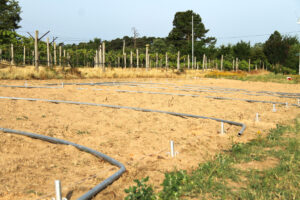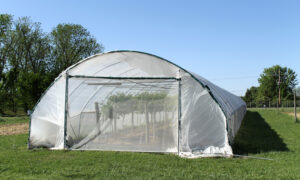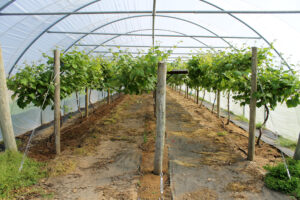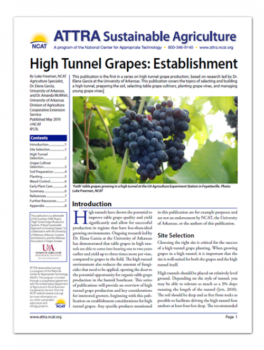High Tunnel Grapes: Establishment
By Luke Freeman, NCAT Agriculture Specialist; Dr. Elena Garcia, University of Arkansas; and Dr. Amanda McWhirt, University of Arkansas Division of Agriculture Cooperative Extension Service
Abstract
This publication is the first in a series on high tunnel grape production, based on research led by Dr. Elena Garcia at the University of Arkansas. This publication covers the topics of selecting and building a high tunnel, preparing the soil, selecting table grape cultivars, planting grape vines, and managing young grape vines.
Introduction
High tunnels have shown the potential to improve table grape quality and yield significantly and allow for successful production in regions that have less-than-ideal growing environments. Ongoing research led by Dr. Elena Garcia at the University of Arkansas has demonstrated that table grapes in high tunnels are able to come into bearing one to two years earlier and yield up to three times more per vine, compared to grapes in the field. The high tunnel environment also reduces the amount of fungicides that need to be applied, opening the door to the potential opportunity for organic table grape production in the humid Southeast. This series of publications will provide an overview of high tunnel grape production and key considerations for interested growers, beginning with this publication on establishment considerations for high tunnel grapes. Any specific products mentioned in this publication are for example purposes and are not an endorsement by NCAT, the University of Arkansas, or the authors of this publication.

This site has been prepared for high tunnel construction at Chateau Aux Arc in Altus, Arkansas. Photo: Luke Freeman, NCAT
Site Selection
Choosing the right site is critical for the success of a high tunnel grape planting. When growing grapes in a high tunnel, it is important that the site is well-suited for both the grapes and the high tunnel itself.
High tunnels should be placed on relatively level ground. Depending on the style of tunnel, you may be able to tolerate as much as a 3% slope running the length of the tunnel (Jett, 2010). The soil should be deep and as free from rocks as possible to facilitate driving the high tunnel foot anchors at least four feet deep. The recommended orientation of the high tunnel is running north to south, allowing for direct sun exposure on both sides of the grape canopy.
Grapes themselves thrive in well-drained soil, so the high tunnel should be placed in a location with good soil drainage. Grapes can tolerate rocky and poor soils, but it is important that your soil is deep enough to support the legs of the high tunnel frame and trellising. Air drainage and air flow are also important. Choosing a site that is slightly elevated will help ensure that cold air drains away from your planting to reduce the risk of cold damage. Also, selecting an open site that receives a cross-breeze will help with the passive ventilation of warm, humid air out of the tunnel and away from the grape canopy. Access to irrigation, electricity, and roads is also important when choosing a site. Avoid sites close to gravel roads, where dust buildup on the tunnel or plants may become an issue.
You should have some idea of how the site was used historically before you plant your grapes. Choosing a location that was once a vineyard site would not be ideal, as that soil could still harbor soil-borne diseases that could infect your new grape vines. Also, ensuring that there are no wild grape vines in the vicinity will help prevent the spread of viruses and diseases into your new planting.
Before building the high tunnel and planting grapes, it is important to prepare the site. Eliminate weeds with cultivation or herbicides and till the soil. Although traditional vineyards may have grassy drive rows, it is not recommended to have any vegetation as groundcover in your high tunnel because of the difficulty of mowing, the potential for vegetation to harbor pests, and an increase in the relative humidity inside the tunnel.

Research at the Arkansas Agriculture Experiment Station utilizes a 25-foot by 200-foot Haygrove Super Solo High Tunnel. Photo: Luke Freeman, NCAT
High Tunnel Selection
There are many high tunnel options. For most areas of the Mid-South and Southeast, a three-season, or caterpillar-style, high tunnel is a suitable and economical option. Haygrove is one manufacturer that has popularized this style of high tunnel with single and multi-bay options. These high tunnels cost less per square foot than most other styles, because they include fewer structural components, which is fine for areas with minimal snowfall. For areas that do receive significant snowfall, gothic-style high tunnels are needed to shed snow and prevent collapse.
When selecting a high tunnel design, be sure to consider the dimensions and height. Research at the University of Arkansas utilizes a 25-foot by 200-foot Haygrove Super Solo High Tunnel that is 12 feet tall at the peak. This allows for three rows of grapes on 8-foot centers, with ample room for canopy growth. A tunnel will also need to allow for ventilation of hot, humid air. In a caterpillar-style tunnel, such as the Haygrove, this is accomplished by manually lifting and bunching the plastic on the sides, which is a very time-intensive task. If you are in a climate where the tunnel will need to be closed and opened frequently in the spring and fall, consider a design that includes a crank for roll-up or roll-down side curtains to save time. End walls will also be needed in areas with potential for late-spring frost damage, allowing the high tunnel to be closed completely to protect vines from frost or freeze damage.
The USDA’s Natural Resource Conservation Service (NRCS) can provide financial assistance to growers who wish to build a high tunnel for in-ground crop production. This program is called the Environmental Quality Incentives Program (EQIP) High Tunnel System. You can contact your local NRCS office to learn more about the program, if you are interested. You can find more information here.
Grape Cultivar Selection
Selecting appropriate cultivars is critical for success with high tunnel grape production. Attributes to consider when selecting cultivars include vigor (speed of vine growth), hardiness (cold tolerance), disease resistance, harvest date (early, mid, or late season), yield potential, grape cluster attributes and flavor, and adaptation to your specific environment. You will find a list of University of Arkansas table grape cultivars with descriptions in Table 1. These grape cultivars have been selected for the warm, humid environment of the Southeast, with varying degrees of disease resistance.
It is important to consider the preferences of your customers and marketing channels when selecting cultivars. Most consumers are accustomed to seedless, non-slipskin table grapes such as ‘Thompson Seedless.’ Most of the Arkansas table grape varieties are “slipskin” grapes, which exhibit the characteristic of the skin easily pulling away from the flesh when bitten into, resulting in flesh and juices squirting out. This attribute is common to American-type or “labrusca” grapes from the species Vitis labrusca. Labrusca grapes are often described as having a “musky” or “foxy” flavor that is either treasured or disliked by consumers, depending on their flavor preferences. Vinifera table grapes are from European parentage, Vitis vinifera, and tend to have a much milder flavor than labrusca (with the exception of muscat-types).
Grape vines should be ordered several months in advance of planting, to ensure availability of desired cultivars. To ensure that the plant material you receive is disease-free, look for nurseries that offer “certified” clean grape vines. States such as California, Missouri, Oregon, and Washington have developed grape-certification programs to ensure disease-free planting material. You can find a list of nurseries that offer Arkansas table grape varieties in the Appendix.
Soil Preparation
Your soil should be tested and site preparation begun at least a year before planting grapes and, ideally, before construction of your high tunnel begins. You can submit soil samples through your local Cooperative Extension office or through private soil testing labs. Collect soil samples to a depth of eight inches with a clean shovel or soil probe from 10 to 15 locations throughout the high tunnel site, sampling in a zig-zag pattern across the area. Mix the soil samples thoroughly in a clean plastic pail and take out a pint of soil for testing. Most soil testing labs will provide you with a box to submit the sample. In Arkansas, you may take the soil sample to your local County Extension Office to be sent in for analysis.

The soil has been amended and tilled at Barnhill Orchards to prepare for grape planting. Photo: Luke Freeman, NCAT
See Table 2 for a list of desirable soil test results for grapes. If your soil pH is below 5.5, add lime to raise the pH to between 5.5 and 6.5. Use dolomitic lime if magnesium is needed; otherwise, calcitic lime will be sufficient. If the soil pH is above 6.5, the soil can be acidified with the addition of sulfur or by using conventional fertilizers such as urea or ammonium sulfate. Elemental sulfur can be used by organic growers. See Changing pH in Soil by Paul Vossen for more information on calculating the amount of lime or sulfur needed to adjust your soil pH. It is best to begin pH adjustment the season before planting.
Soil organic matter can be increased through the application of animal manures and compost or by growing cover crops prior to planting. If your soil is deficient in P, K, Mg, B, or Zn, these nutrients can be increased by the application of fertilizers in the spring prior to planting. For a list and discussion of organic fertilizers, see Cornell University’s Organic Production and IPM Guide for Grapes and ATTRA’s Alternative Soil Amendments. You can also reference the OMRI List of approved materials for organic farming.
Growing cover crops can increase soil organic matter, in addition to improving soil quality and suppressing weeds and diseases. See the SARE publication Managing Cover Crops Profitably for a list of cover crops that are appropriate for your region. Most grass species will help build soil organic matter and suppress weeds, while legume cover crops will increase soil N through biological fixation. Mustard species can be grown to suppress soil-borne diseases and nematodes. If growing cover crops for your grape planting, start with summer cover crops planted in the spring the year before planting grapes or winter cover crops planted in the fall. Ensure that the cover crops have been incorporated into the soil at least three weeks prior to planting the grapes, to allow ample time for decomposition.
Ideally, the trellis and irrigation systems should be constructed prior to planting the grapes. It will be much easier to use augers and other tractor equipment to set the trellis posts if you do not have to worry about avoiding the young vines. You may even wish to construct the trellis prior to erecting the high tunnel, for similar reasons. The high tunnel could be laid out and ground anchors set before building the trellis so that the footprint of the tunnel is established. You can read more about building a grape trellis in ATTRA’s High Tunnel Grapes: Pruning, Trellising, and Training publication.
A basic irrigation system consists of one line of drip tape or ¾-inch drip tubing per row. Drip tubing is often placed 10 to 12 inches above the soil. Drip emitters are either built into the tubing (in-line emitters) or manually added at your desired spacing (on-line emitters).
Planting
If you are not able to plant your grape vines immediately upon receipt, the vines can be held in a cooler at 36°F and a high relative humidity for several weeks until planting. Do not store vines with fruits or vegetables. Prior to planting, the vine roots should be soaked in water for two to three hours to increase their chance of survival (Galetta and Himelrick, 1990). When bringing your vines to the field it is best to leave them in a bucket of water or wrapped in moist material to keep the roots from drying out.
It will speed the planting process if holes are already dug at the appropriate plant spacing. In the field, spacing between plants varies according to the trellis system used and the vigor of the selected cultivars. However, a common plant spacing is five to six feet between vines. Research at the University of Arkansas has shown that eight feet between plants is a more appropriate spacing for seedless table grapes in the high tunnel, considering the trellising system used and the vigorous vine growth. Eight to nine feet between the rows is recommended, which allows for three rows in a 25-foot-wide high tunnel.

Grape vines have been planted in the high tunnel at the Arkansas Fruit Research Station in Clarksville. Photo: Luke Freeman, NCAT
The planting holes should be 10 to 12 inches deep and wide enough to accommodate the root system being spread out—usually 12 inches. Vines should be set to the depth that they were grown in the nursery, making sure to bury all roots. If you have grafted vines, it is important to set the plants so that the graft union is at least two inches above the soil line. Dead roots should be pruned out, but avoid additional pruning of the root system unless necessary. After the plants are set and roots spread out in the planting hole, you can backfill with soil, lightly packing the soil around the roots. Check out our YouTube video on planting grapes.
Fertilizer should not be placed in the planting hole, as it can damage the young roots. If the native soil fertility is low and additional fertilizer is needed in the first year, four ounces of 10-10-10 fertilizer can be applied to the soil surface around the vine after planting (Galetta and Himelrick, 1990). Organic growers can use eight ounces of an organic fertilizer such as feather meal or fish emulsion with 5% N, instead. Take care to avoid excess fertilizer application, which can stimulate late-summer growth and increase the susceptibility of the vines to winter injury.

Landscape fabric is used to eliminate weeds in the walkways, with cultivation used in the planting rows. Photo: Luke Freeman, NCAT
Weed Control
Weeds should be kept to a minimum in your high tunnel, as they will compete with the young grape vines for water and nutrients and can harbor insect pests. The best option for weed control in the high tunnel is polypropylene landscape fabric, which will create a physical barrier to prevent weeds from growing in the walkways and rows. A strip of soil will need to be kept bare for planting, but weeds can easily be controlled with hand cultivation or herbicides in this bare strip under the vines. If you use landscape fabric that is six feet wide in between planting rows at 8-foot centers, that will leave a 2-foot strip of soil that will need to be cultivated. The vines will eventually shade out the soil and keep weed growth to a minimum. Most horticulture supply companies sell landscape fabric. Look for 5-ounce material that is rated for 20 years, such as the DeWitt Pro-5 Weed Barrier. You will also need to purchase anchor pins or landscape staples to hold down the fabric. For herbicide options, refer to regional Extension publications such as the 2017 Southeast Regional Bunch Grape Integrated Management Guide.
Early Plant Care
Fertilizer should be kept to a minimum in the first year after planting. However, irrigation will need to be provided to keep the soil moist and encourage root growth. Two shoots should be left on each vine, with all others rubbed or pinched off. To encourage a straight trunk, the shoots should be tied to the trellis wire using a string hung from the wire and tied loosely around the base of the plant. After establishment of the main trunk, the training string should be cut from the plants to prevent girdling. Any flower clusters that appear in the first year should be removed. Vine growth in the high tunnel is accelerated, which means the main shoot will likely reach the trellis wire in the first year and shoots will need to be trained to create cordons. You can find more information on training and trellising in ATTRA’s High Tunnel Grapes: Pruning, Trellising, and Training publication.

Young grape vines in the high tunnel at Barnhill Orchards are trained to the trellis three months after planting. Photo: Luke Freeman, NCAT
Rodents can pose a risk to young grape vines by gnawing on the trunk and potentially girdling the vine, especially during winter. Good weed-control practices and keeping the area around the high tunnel mowed will reduce the incidence of rodent damage by eliminating their shelter. Deer can also damage young grape vines by feeding on the tender shoots. Deer fencing should be installed around the perimeter of the planting area, or the high tunnel should be screened to prevent deer intrusion if deer are a problem in your area.
Summary
Successful high tunnel grape production begins with proper establishment of the high tunnel and the grape vines. Select a high tunnel design that is able to withstand the weather extremes of your location and provide protection to the grape vines. Likewise, choose grape cultivars that are adapted to your environment and the preferences of your customers and markets. Proper soil preparation and weed control prior to planting will go a long way in helping to give the grapevines a strong start. By following best practices in establishment, you will be increasing the likelihood of success with high tunnel grapes.
High Tunnel Grapes: Establishment
By Luke Freeman, NCAT Agriculture Specialist; Dr. Elena Garcia, University of Arkansas; and Dr. Amanda McWhirt, University of Arkansas Division of Agriculture Cooperative Extension Service
Published May 2019
© NCAT 2019
IP576
Slot 602
Version 052119
This publication is produced by the National Center for Appropriate Technology through the ATTRA Sustainable Agriculture program, under a cooperative agreement with USDA Rural Development. This publication was also made possible in part by funding from Southern SARE Grant, “High Tunnel Grape Production Systems: A Novel Sustainable Approach to Growing Grapes,” in collaboration with the University of Arkansas, Arkansas Cooperative Extension, and the Arkansas Association of Grape Growers.
Related Publications
- High Tunnel Grapes: Pest Management
- High Tunnel Grapes: Temperature and Soil Management
- High Tunnel Grapes: Harvest and Quality Considerations
- High Tunnel Grapes: Pruning, Trellising, and Training
- High Tunnel Grape Production: An Economic Analysis
- High Tunnel Tree Fruit and Grape Production for Eastern Growers
- Grapes: Organic Production
- High Tunnels in Urban Agriculture


